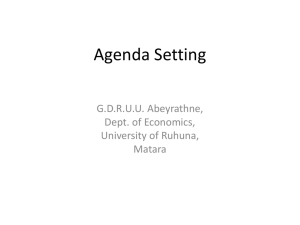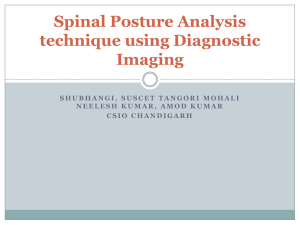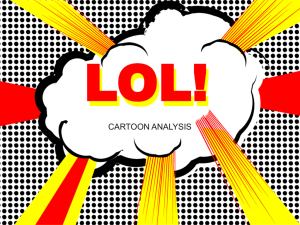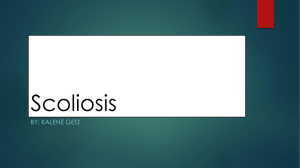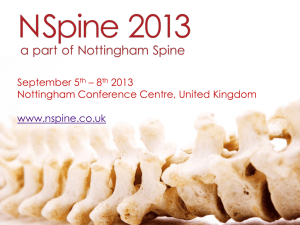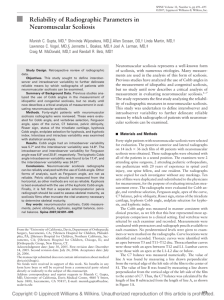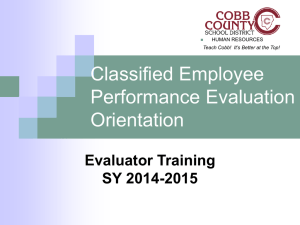Andrew Thome - School of Medicine
advertisement
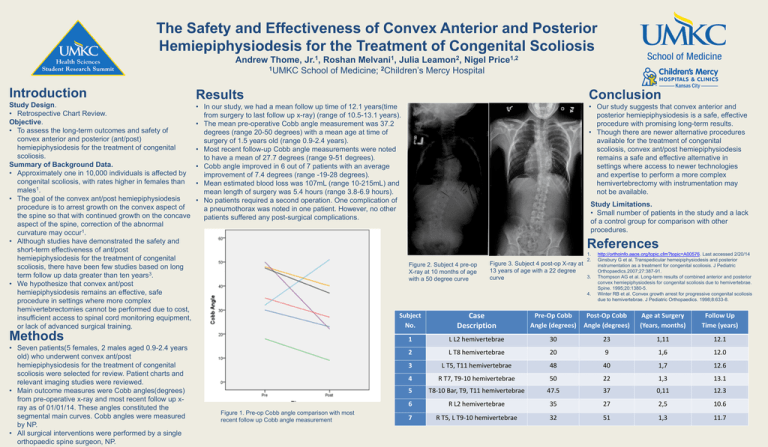
The Safety and Effectiveness of Convex Anterior and Posterior Hemiepiphysiodesis for the Treatment of Congenital Scoliosis Andrew Thome, Jr.1, Roshan Melvani1, Julia Leamon2, Nigel Price1,2 1UMKC School of Medicine; 2Children’s Mercy Hospital Introduction Results Conclusion Study Design. • Retrospective Chart Review. Objective. • To assess the long-term outcomes and safety of convex anterior and posterior (ant/post) hemiepiphysiodesis for the treatment of congenital scoliosis. Summary of Background Data. • Approximately one in 10,000 individuals is affected by congenital scoliosis, with rates higher in females than males1. • The goal of the convex ant/post hemiepiphysiodesis procedure is to arrest growth on the convex aspect of the spine so that with continued growth on the concave aspect of the spine, correction of the abnormal curvature may occur1. • Although studies have demonstrated the safety and short-term effectiveness of ant/post hemiepiphysiodesis for the treatment of congenital scoliosis, there have been few studies based on long term follow up data greater than ten years3. • We hypothesize that convex ant/post hemiepiphysiodesis remains an effective, safe procedure in settings where more complex hemivertebrectomies cannot be performed due to cost, insufficient access to spinal cord monitoring equipment, or lack of advanced surgical training. • In our study, we had a mean follow up time of 12.1 years(time from surgery to last follow up x-ray) (range of 10.5-13.1 years). • The mean pre-operative Cobb angle measurement was 37.2 degrees (range 20-50 degrees) with a mean age at time of surgery of 1.5 years old (range 0.9-2.4 years). • Most recent follow-up Cobb angle measurements were noted to have a mean of 27.7 degrees (range 9-51 degrees). • Cobb angle improved in 6 out of 7 patients with an average improvement of 7.4 degrees (range -19-28 degrees). • Mean estimated blood loss was 107mL (range 10-215mL) and mean length of surgery was 5.4 hours (range 3.8-6.9 hours). • No patients required a second operation. One complication of a pneumothorax was noted in one patient. However, no other patients suffered any post-surgical complications. • Our study suggests that convex anterior and posterior hemiepiphysiodesis is a safe, effective procedure with promising long-term results. • Though there are newer alternative procedures available for the treatment of congenital scoliosis, convex ant/post hemiepiphysiodesis remains a safe and effective alternative in settings where access to newer technologies and expertise to perform a more complex hemivertebrectomy with instrumentation may not be available. References Figure 2. Subject 4 pre-op X-ray at 10 months of age with a 50 degree curve Figure 3. Subject 4 post-op X-ray at 13 years of age with a 22 degree curve 1. 2. 3. 4. Methods • Seven patients(5 females, 2 males aged 0.9-2.4 years old) who underwent convex ant/post hemiepiphysiodesis for the treatment of congenital scoliosis were selected for review. Patient charts and relevant imaging studies were reviewed. • Main outcome measures were Cobb angles(degrees) from pre-operative x-ray and most recent follow up xray as of 01/01/14. These angles constituted the segmental main curves. Cobb angles were measured by NP. • All surgical interventions were performed by a single orthopaedic spine surgeon, NP. Study Limitations. • Small number of patients in the study and a lack of a control group for comparison with other procedures. Figure 1. Pre-op Cobb angle comparison with most recent follow up Cobb angle measurement http://orthoinfo.aaos.org/topic.cfm?topic=A00576. Last accessed 2/20/14 Ginsbury G et al. Transpedicular hemeipiphysiodesis and posterior instrumentation as a treatment for congenital scoliosis. J Pediatric Orthopaedics.2007;27:387-91. Thompson AG et al. Long-term results of combined anterior and posterior convex hemiepiphysiodesis for congenital scoliosis due to hemivertebrae. Spine. 1995;20:1380-5. Winter RB et al. Convex growth arrest for progressive congenital scoliosis due to hemivertebrae. J Pediatric Orthopaedics. 1998;8:633-8. Subject No. Case Description Pre-Op Cobb Angle (degrees) Post-Op Cobb Angle (degrees) Age at Surgery (Years, months) Follow Up Time (years) 1 L L2 hemivertebrae 30 23 1,11 12.1 2 L T8 hemivertebrae 20 9 1,6 12.0 3 L T5, T11 hemivertebrae 48 40 1,7 12.6 4 R T7, T9-10 hemivertebrae 50 22 1,3 13.1 5 T8-10 Bar, T9, T11 hemivertebrae 47.5 37 0,11 12.3 6 R L2 hemivertebrae 35 27 2,5 10.6 7 R T5, L T9-10 hemivertebrae 32 51 1,3 11.7
